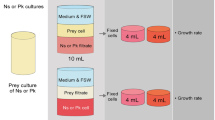Abstract
The interaction effects between irradiance and temperature on growth rates ofNannochloropsis oceanicawere determined in both laboratory cultures and large-scale tubular photobioreactors. Growth responses were investigated in 48 batch cultures subjected to crossing light/temperature gradients ranging from 34–80μmol photons m−2s−1and 14.5–35.7∘C respectively. Comparisons were made to growth responses observed in production systems (200L biofences) operated in climate-regulated greenhouses with controlled temperature and artificial light gradients. Cellular responses showed increasing specific growth rates as a function of temperature, with a peak at 25–29∘C, after which the growth became increasingly unstable. The optimum temperature for growth increased with higher light intensities up to approximately 28∘C at 80μmol photons m−2s−1. At low light intensities the specific growth rate was less affected by temperature. The maximum daily production measured in the biofence systems increased proportionally with irradiation and reached approximately 0.7gL−1d−1at 1030μmol photons m−2s−1average daily radiation for a culture temperature of 24∘C. This corresponds to a daily yield of 140g per day in a 200L biofence system. When specific growth rates for the biofence cultures were measured at different densities and plotted against temperature, results showed a peak with the 24∘C temperature treatment. This peak became less pronounced as the density increased in the cultures. This is consistent with the laboratory results; increasing cell density in the biofence cultures resulted in less average light cell−1, which produced the same temperature dependent response as seen by reducing the external irradiance exposure for the dilute laboratory cultures.
Similar content being viewed by others
References
Acién Fernández FG, Garcia Camacho F, Sanchez Perez JA, Fernández Sevilla, JM, Molina Grima E (1997) A model for light distribution and average solar irradiance inside outdoor tubular photobioreactors for the microalgal mass culture. Biotechnol. Bioeng. 55: 701–714.
Carvalho AP, Malcata FX (2003) Kinetic modeling of the autotrophic growth of Pavlova lutheri: Study of the combined influence of light and temperature. Biotechnol. Prog. 19: 1128–1135.
Chini Zittelli G, Rodolfi L, Tredici MR (2004) Industrial production of microalgal cell-mass and secondary products–species of high potential. Mass cultivation of Nannochloropsis in closed systems. In: Richmond A (ed), Handbook of Microalgal Culture, Biotechnology and Applied Phycology, Blackwell Science Ltd, UK, pp. 298–303.
Coles JF, Jones RC (2000) Effect of temperature on photosynthesis-light response and growth of four phytoplankton species isolated from a tidal freshwater river. J. Phycol. 36: 7–16.
Collins CD, Boylen CW (1982) Physiological responses of Anabaena variabilis (Cyanophyceae) to instantaneous exposure to various combinations of light intensity and temperature. J. Phycol. 18: 206–211.
Dermoun D, Chaumont D, Thebault J, Dauta A (1992) Modelling of growth of Porphyridium cruentum in connection with two interdependent fators: Light and temperature. Bioresource Technol. 42: 113–117.
Frohlich BT, Webster IA, Ataai MM, Shuler ML (1983) Photobioreactors: Models for interaction of light intensity, reactor design and algal physiology. Biotechnol. Bioeng. Symp. 13: 331–350.
Goldman JC (1979) Temperature effects on steady-state growth, phosphorus uptake, and the chemical composition of a marine phytoplankter. Microb. Ecol. 5: 153–166.
Grobbelaar JU (1991) The influence of light dark cycles in mixed algal cultures on their productivity. Bioresource Technol. 38: 189–194.
Guillard RRL (1975) Culture of phytoplankton for feeding marine invertebrates. In: Smith WL, Chanley MH (eds), Culture of Marine Invertebrate Animals, Plenum Press, New York, USA, pp. 26–60.
Hart M, Brennan D, Campbell C (2005) Identification of Nannochloropsis strain by DNA extraction and sequencing of 18S rDNA. CCAP, Scotland, UK, Report Ref. No. 2005/1.
Hu Q, Gutterman H, Richmond A (1996). A flat inclined modular photobioreactor for outdoor mass cultivation of photoautotrophs. Biotechnol. Bioeng. 51: 51–60.
Masojídek J, Koblížek M, Torzillo G (2004) Photosynthesis in microalgae. In: Richmond A (ed.), Handbook of Microalgal Culture, Biotechnology and Applied Phycology. Blackwell Science Ltd, UK, pp. 20–39.
Molina Grima E, Fernández Sevilla JM, Sanchez Perez JA, Garcia Camacho F (1995) A study on simultaneous photolimitation and photoinhibition in dense microalgal cultures taking into account incident and averaged irradiances. J. Biotechnol. 45: 59–69.
Molina Grima E, Acién Fernández FG, Garcia CF, Chisti Y (1999) Photobioreactors: Light regime, mass transfer, and scale-up. J. Biotechnol. 70: 231–247.
Rabe AE, Benoit A (1962) Mean light intensity. A useful concept in correlating growth rates of dense cultures of microalgae. Biotechnol. Bioeng. 4: 337–390.
Richmond A (1986) Cell response to environmental factors. In: Richmond A (ed), Handbook of Microalgal Mass Culture, CRC Press, Boca Raton, FL. pp. 69–99.
Richmond A (2004) Biological priciples of mass cultivation. In: Richmond A (ed), Handbook of Microalgal Culture, Biotechnology and Applied Phycology, Blackwell Science Ltd, UK, pp. 125–178.
Sandnes J.M., Ringstad T, Wenner D, Heyerdahl P.H, Källqvist T, Gislerød HR (2005) Real-time monitoring and automatic density control of large-scale microalgal cultures using near infrared (NIR) optical density sensors (submitted).
Thompson PA, Guo M (1992) Effects of variation in temperature. I. On the biochemical composition of eight species of marine phtoplankton. J. Phycol. 28: 481–488.
Zhang Z, Zmora O, Kopel R, Richmond A. (2001) An industrial-size flat plate glass reactor for mass production of Nannochloropsis sp. (Eustigmatophyceae). Aquaculture 195: 35–49.
Author information
Authors and Affiliations
Corresponding author
Rights and permissions
About this article
Cite this article
Sandnes, J.M., Källqvist, T., Wenner, D. et al. Combined influence of light and temperature on growth rates of Nannochloropsis oceanica: linking cellular responses to large-scale biomass production. J Appl Phycol 17, 515–525 (2005). https://doi.org/10.1007/s10811-005-9002-x
Received:
Accepted:
Published:
Issue Date:
DOI: https://doi.org/10.1007/s10811-005-9002-x




